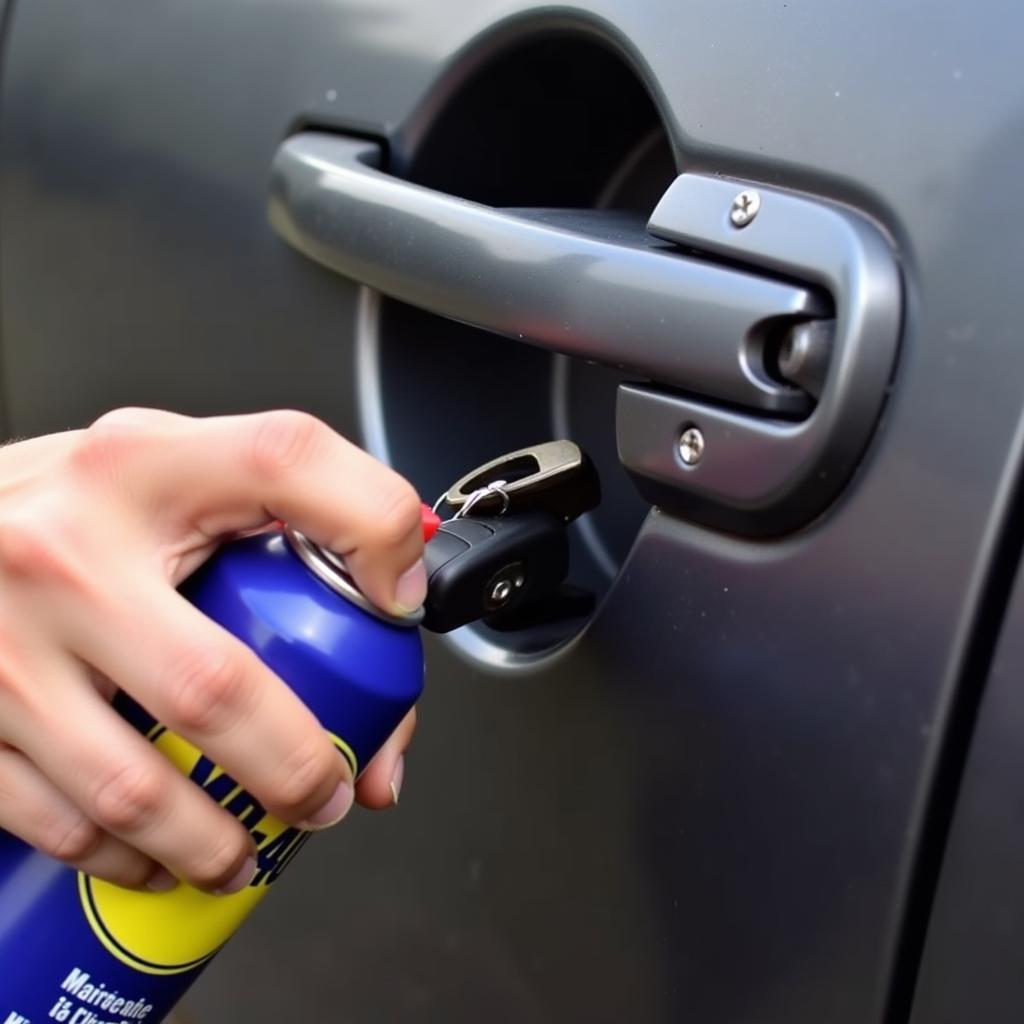A sticking car door lock can be a real nuisance, leaving you stranded or frustrated. This guide provides effective solutions to troubleshoot and fix this common car problem, whether you’re a car owner, mechanic, or technician. Let’s dive in and get that door lock working smoothly again. For additional information about door handles, you can check how to fix a broken car handle.
Understanding Why Your Car Door Lock is Sticking
Before jumping into solutions, it’s important to understand the potential causes. A sticking car door lock can stem from several issues, including a build-up of dirt and grime, a faulty actuator, a bent or broken lock rod, or even a worn-out key. Identifying the root cause is crucial for effective repair.
Common Causes and Quick Fixes for a Sticking Car Door Lock
Several factors can contribute to a sticky car door lock. Here are some of the most common culprits and their corresponding solutions:
Dirt and Debris
- The Problem: Over time, dirt, dust, and grime can accumulate in the lock mechanism, hindering its smooth operation. This is often the easiest problem to fix.
- The Solution: Use a lubricant like WD-40 or graphite spray to loosen the dirt and debris. Spray it directly into the keyhole and lock cylinder. Insert and remove the key several times to work the lubricant in. For more detailed information on how to fix a car door lock, check this guide: [how to fix car door lock](https://autotippro.com/how to fix car door lock/).
 Cleaning Car Door Lock with WD-40
Cleaning Car Door Lock with WD-40
Frozen Lock
- The Problem: In colder climates, moisture inside the lock can freeze, effectively jamming the mechanism.
- The Solution: Use a de-icer specifically designed for car locks. Avoid using hot water, as this can damage the lock and surrounding components. Alternatively, you can try warming your key with a lighter and inserting it into the lock to melt the ice.
Faulty Actuator
- The Problem: The actuator is the electronic component responsible for locking and unlocking the door. If it’s malfunctioning, the lock may stick or refuse to operate altogether. This often requires more involved repairs. If you’re looking at replacing parts, you might want to consider the cost to fix side door handle on car before starting.
- The Solution: Testing the actuator with a multimeter can determine if it’s faulty. Replacing the actuator is usually the best course of action, which may require professional assistance. You can find resources online for how to fix car door latch without replacement, which may offer some temporary solutions.
 Testing Car Door Actuator with Multimeter
Testing Car Door Actuator with Multimeter
Bent or Broken Lock Rod
- The Problem: The lock rod connects the lock cylinder to the locking mechanism inside the door. If it’s bent or broken, the lock may not engage properly.
- The Solution: Accessing and inspecting the lock rod usually requires removing the door panel. If you find the rod is damaged, it will need to be replaced.
Worn-Out Key
- The Problem: Over time, keys can wear down, making it difficult for them to interact with the lock tumblers effectively.
- The Solution: Try a spare key. If the spare key works smoothly, you know the original key is the problem. Get a new key cut.
Preventing Future Sticking
Regular maintenance can prevent future issues. Periodically lubricate the lock cylinder and keep it free of debris. Protecting the lock from extreme temperatures can also help prevent freezing or damage.
“Preventive maintenance is key to a smoothly operating car door lock. A little lubrication goes a long way.” – Johnathan Davis, Automotive Engineer
When to Seek Professional Help
While many sticking car door lock issues can be resolved with DIY solutions, some situations require professional intervention. If you’ve tried the troubleshooting steps outlined above and the lock is still sticking, it’s time to consult a qualified automotive locksmith or mechanic.
“Don’t hesitate to seek professional help if the problem persists. A qualified technician can diagnose and repair complex lock issues effectively.” – Maria Sanchez, Certified Automotive Locksmith
Conclusion
A sticking car door lock can be a frustrating experience, but with the right approach, it’s often a fixable problem. By understanding the potential causes and applying the appropriate solutions, you can get your car door lock working smoothly again. Remember, regular maintenance is essential for preventing future sticking. For more help with car door issues, you can read about fixing car door latch without replacement here: how to fix car door latch without replacement. If you are still having problems, please connect with AutoTipPro at +1 (641) 206-8880 or visit our office at 500 N St Mary’s St, San Antonio, TX 78205, United States.
FAQ
- What is the most common cause of a sticking car door lock? Dirt and debris buildup is often the primary culprit.
- Can I use any lubricant on my car door lock? WD-40 or graphite spray are recommended. Avoid using oil-based lubricants, as they can attract more dirt and grime.
- How often should I lubricate my car door lock? Every few months or as needed, especially in harsh weather conditions.
- What should I do if my car door lock is frozen? Use a de-icer specifically designed for car locks or try warming your key.
- Is it safe to try fixing a faulty actuator myself? If you’re comfortable with basic car repairs, you can attempt it. However, if you’re unsure, it’s best to consult a professional.
- How much does it cost to replace a car door lock? The cost varies depending on the make and model of your car, but it typically ranges from $100 to $300.
- How can I prevent my car door lock from sticking in the future? Regular lubrication and keeping the lock free of debris are key preventive measures.





Leave a Reply